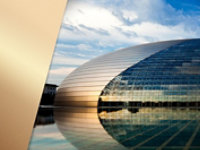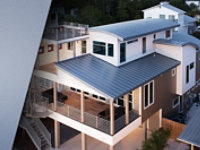From Past to Present, PVDF Coatings Remain a Leader in the Architectural Paint Industry
Today, coatings come in all colors, textures and patterns, and as companies continue to create innovative and technologically advanced solutions, it is no surprise the foundation of their success stems from PVDF resin-based coatings. No matter what part of country you live in or what your line of profession, chances are PVDF coatings are a part of your life without you even knowing. From barns and storage sheds, to arenas and skyscrapers, exterior metal paneling all throughout the world is clad with PVDF coating. So, what are PVDF coatings and how have they become a staple in the industry?
A Brief History of PVDF Coatings
Originally introduced to the market in 1965, 70 percent PVDF coatings have steadily become one of the most popular and respected coil and extrusion coatings available on the market. PVDF stands for polyvinylidene difluoride, a fluoropolymer resin and over the last half-century, no other architectural product has more decisively stood the test of time than 70 percent PVDF resin-based coatings. Continuous technological improvements have contributed to the longevity of the coating, resulting in additional formulations and practices for applications that have distinct requirements.
Widely produced by various manufacturers, PVDF coatings are also branded with an assortment of trademarked names. This often makes it difficult for industry outsiders to tell coating manufacturers and resin manufacturers apart. Furthermore, despite coatings from different manufacturers often containing similar PVDF resins, the application and performance of the paint systems can widely vary due to the proprietary formulations of each company. Two of the most widely recognized brands of PVDF resins in the U.S. are Hylar® by Solvay Solexis and Kynar® by Arkema Inc. Both offer comparable performance per industry standards for weathering.
Leading coating manufacturers, including Valspar, continue to develop unique formulations that meet the growing demands and creative applications of architects, developers and construction companies. More recent innovations include energy-efficient, solar-reflective and color-changing coatings, as well as enhanced application properties and more reliable color consistency.
PVDF Clads The Pavilion with Color and Protection
PVDF coatings are used on a wide variety of structures, from elementary schools to residential homes, and even The Pavilion, the new $96.5 million basketball arena at Ole Miss.
The University of Mississippi, founded in 1848, recently commissioned the new arena to be utilized as a multi-purpose facility for events such as men’s and women’s basketball games, graduation ceremonies, concerts and other university-wide occasions.
Work on the facility began with a groundbreaking ceremony in July 2014, and opened to great fanfare during a weekend long celebration, January 7-10, 2016. The facility was designed by AECOM Technology, an architecture and engineering firm based in Kansas City, Missouri. BL Harbert International located in Birmingham, Alabama was the general contractor with experience building several other SEC arenas.
The facility consists of a three-story structural steel frame supporting steel trusses. From the exterior, it wields an elegant footprint in spite of its scale, one that is enhanced by a curved and colonnaded entrance façade that echoes The Pavilion’s signature curved roof. The roof is clad in metal paneling manufactured by ACI Building Systems LLC and coated with Valspar’s Fluropon in Terra Cotta, a rich earth-tone hue.
Chosen from an extensive list of colors, Valspar’s Fluropon 70 percent PVDF coating in Terra Cotta is a premium, high performance product that offers some of the most advanced durability and aesthetic features. Architects and building owners alike, can trust that the Fluropon coating used on the roof of The Pavilion will provide the following properties:
Film integrity and adhesion quality. One of the defining features of PVDF coatings, are their erosion rate, the amount of time at which a coating degrades. The erosion rates of PVDF coatings are relatively small, an essential factor for their advanced color and design longevity. The quality of PVDF coating adhesion depends on the superiority of the primer that adheres to the substrate. The primer is meant to create a strong bond with the PVDF topcoat, which helps resist the stresses of forming and weathering.
Chalk and fade resistance. In order to ensure protection against chalking and fading, the correct formulation is crucial. The carbon-fluorine bond is one of the strongest chemical bonds and gives PVDF resin-based coatings their stubborn resistance to chalking and erosion, as well as harsh airborne industrial and atmospheric pollutants.
UV resistance. Of any polymer used within coatings today, PVDF coatings are the leaders when it comes to UV resistance, delivering an eco-friendly way to resist heat absorption from the sun. As exemplified by the use of Valspar’s Fluropon coating on The Pavilion, PVDF coatings not only help lower energy cooling costs and keep interior spaces like the arena more comfortable for fans, but do so without sacrificing durability, performance or beauty.
Valspar’s Fluropon is a leading example of modern PVDF coating formulation, offering exceptional durability properties. In the example of The Pavilion, combined with the ACI panels, its striking roof will endure lustrous beauty for years to come.
How is a Coating Manufactured and Applied?
To achieve the many durability and environmental benefits of PVDF coatings, manufacturers create unique formulations, which include the use of resins, solvents, pigments, and additives.
Resins are the principal component that determines the appearance, durability and performance of a coating and serve as the binder that forms the paint film. Common resin names outside of PVDF coatings are epoxy, silicone modified polyester, polyester and urethane. Furthermore, solvents are used to thin a coating mixture’s consistency in order for it to be properly applied. Solvents steadily evaporate during the curing process as the resin system adheres to the substrate.
Pigments not only add the color and visual features to a coating, but they also influence its durability. Additives are used for processing pigments within the film, flow and smoothness, regulating the rate of the cure, and enhancing the coating’s hardness, gloss, mar resistance and other performance features.
Coil Coating Process
Extrusion Spray Process
PVDF resin-based coatings are available in both coil and extrusion forms. The coil-coating process begins with a flat sheet, coil-coated or pre-painted architectural building product that is then molded into a specific shape that includes wall or roof panels as well as gutters.
In contrast to the process of coil coating, which is applied to metal prior to being shaped into an architectural building product, the aluminum extrusion process creates the metal form before a finish is applied. The shape of the die determines the shape of the extrusion, and by using an aluminum billet with a powerful hydraulic press, extruders can produce nearly any shape possible. The most common examples of extruded aluminum are fenestration products, which include curtain wall, window framing, storefronts and entrance systems.
Thanks to the advanced finishes of PVDF coatings, renovated buildings and those that are new such as The Pavilion at Ole Miss, will remain vibrant and durable for many years to come.

